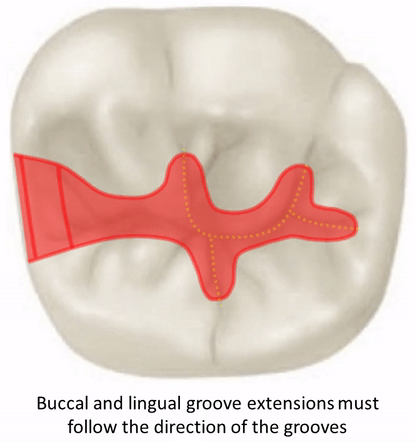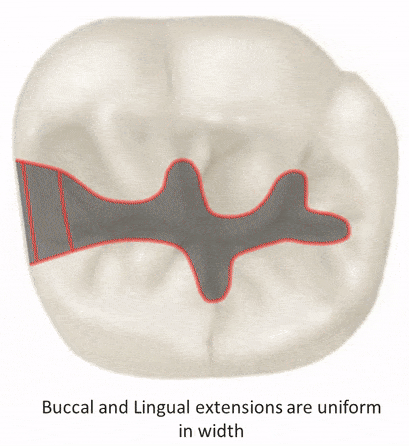There is a huge inquiry about how should the buccal and lingual extension should look like so the outline form regarding these extensions is one of the most often seen mistake. There are no definite guidelines on buccal and lingual groove extensions for these are often dictated by the extent of caries. However, since we are dealing with an intact tooth and must create an ideal preparation, we have to create these extensions in a way that they are rather being dictated by how it should be balanced with the rest of the outline form and follow the “extension for prevention” rule. Doing the extensions should also abide with the principle of preservation of tooth structure thus the size and width of it is also being kept in control.
There are three things to keep in mind:
- Direction
- Width
- The size of Entry
DIRECTION:
Groove extensions are named such because they should lie on the supplemental grooves. The most common problem is that the outline form do not follow the grooves itself. To avoid this mistake, always pre-plan. Think about how your bur should go in the direction same as with the supplemental grooves. The key here is to have a firm hand rest so that you can control your bur effectively and direct it easily to where you want it to go.
WIDTH:
There is no strict guidelines about the width of the extension. However, we must still have to make sure that the width should be proportionate with the rest of the outline form, thus there is no reason for it to be wider than the isthmus width. Creating the width with just 1mm using a 330 bur is to narrow for an extension but at least we have a guide to not go over too much beyond that measurement. To check if you have the enough width, the bur should pass through passively (without resistance from the walls) but still feels snug fit.
ENTRY:
The entrance of this extension from the center of the outline form should not be wide. It will still have to be uniform with the width of the entire proportion of the extension. This is to ensure that the cusp that flanks the extension will still be intact. There should be a clear distinction of the outline around the cusp and the entryway of the extension. To illustrate, refer to this picture:


